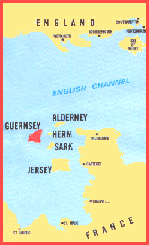History of Guernsey and the Can
|
History of Guernsey and the Can |
| The Island of Guernsey | |||
Guernsey is one of the Channel Islands situated in the Gulf
of St. Malo about 30 miles from the Normandy coast of France and 80 miles from the south coast of England. It has a
land area of approx. 24 square miles with a coast line of 45 miles. English is
the official language, although a Norman-French patois is still spoken by some
of the older population.
Normandy coast of France and 80 miles from the south coast of England. It has a
land area of approx. 24 square miles with a coast line of 45 miles. English is
the official language, although a Norman-French patois is still spoken by some
of the older population.Originally part of the French Duchy of Normandy, the Channel Islands became linked to the English Crown with the conquest of England by William, Duke of Normandy in 1066 AD. Today the islands are considered to be part of the British Isles but not of the United Kingdom. They are internally self-governing, making their own laws and establishing their own taxes. |
|||
| The Guernsey Can | |||
|
The Guernsey Can, the last surviving relic of Guernsey's Norman ancestry with a pedigree of nearly one thousand years, is the pride of every true Guernsey home, whether granite cottage, farmhouse, or manor of a feudal fief.
The can's shape permits the least loss by "slopping" of the precious milk, so rich in cream and colour. Guernsey's wedding gift to H.M. the Queen, then Princess Elizabeth, and Prince Philip, now Duke of Edinburgh, comprised a set of six, ranging from half-pint to three pints. They bore the seal of the Bailiwick of Guernsey which dates back to reign of Edward 1. Guernsey's wedding gift to the late Princess Margaret was a Gold Miniature Can. Illustrious visitors to Guernsey such as the late Princess Marina and Field Marshal Viscount Montgomery received these cans as gifts from the States of Guernsey and its people. |
|||
| Sausmarez Manor | |||
|
The Edwardian Tin, Copper &
Silverworks are sited within the 'Tudor Barn' at Sausmarez Manor, Guernsey.
|
|||
| Home | History | The Maker | Ordering | Renovations/Design | Bracelets, etc | Links | Privacy |